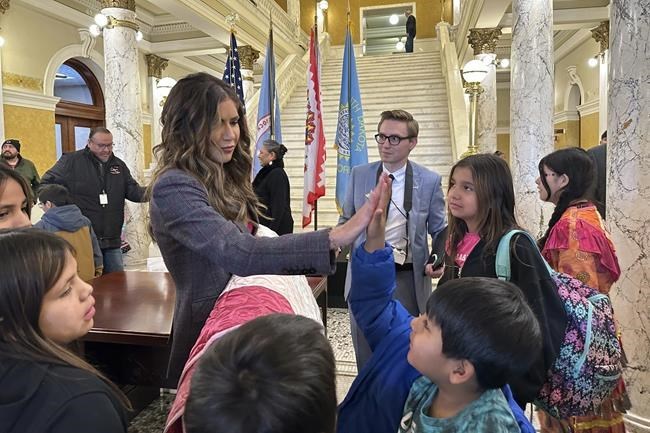
South Dakota Republican Gov. Kristi Noem greets children after a ceremony for the flags of the Standing Rock and Rosebud Sioux tribes in the rotunda of the state Capitol in Pierre, S.D., Wednesday, Jan. 10, 2024. Representatives from the two tribes presented the flags to Noem, whose office is in talks with the seven other tribes within South Dakota's boundaries about inviting them to offer a flag for display. Standing Rock and Rosebud tribal leaders praised the display of their flags as cooperative and unifying. (AP Photo/Jack Dura)
January 10, 2024 - 2:03 PM
PIERRE, S.D. (AP) — Gov. Kristi Noem and tribal leaders celebrated the new display of two tribal nations' flags on Wednesday at the South Dakota Capitol as a symbol of unity. But at least one tribe sees more to be done before it gives its flag.
Representatives of the Standing Rock and Rosebud Sioux tribes presented their flags, three years after Noem signed legislation to display flags in the state Capitol of the nine tribal nations within South Dakota’s boundaries.
While relations between Noem and various tribes have not been without tension during her tenure, tribal leaders praised the move as cooperative and unifying.
“For me, we want to build these relationships so we can help our people,” Standing Rock Sioux Tribal Chairwoman Janet Alkire said in an interview.
Alkire said the flag display signifies a spirit of cooperation and commitment to ensuring a state-tribal partnership.
Standing Rock, which straddles the North Dakota-South Dakota border, also has its flag displayed at the North Dakota Capitol. Gov. Doug Burgum in 2019 announced the display of tribal flags in that statehouse.
Alkire said she would like South Dakota lawmakers to see the flag and her tribe's colors as they perform their duties to the state and to know they represent Standing Rock, too.
Noem highlighted state-tribal relationships and agreements on such issues as law enforcement, sales tax collections and distributions, social services, Medicaid, and other areas.
“It has been my great honor to work with our tribal nations,” Noem said. “It has been a privilege for me to be able to spend time with them, to be able to learn the culture and more in-depth, and to be a part of the way of life that they enjoy and that they share with future generations and share with me and my family.”
But the Crow Creek Sioux Tribe isn’t ready to offer its flag, "not the way things are now," Crow Creek Sioux Tribal Chairman Peter Lengkeek said.
“We don’t see enough transparency, enough accountability. We don’t see any acknowledgement of the tribes,” Lengkeek said. “The governor, these legislators, they’ll stand there and say we have these nine tribes and this and that, but true acknowledgement of tribes, I have not seen yet.”
Noem has drawn the ire of tribes over the years. In 2019, the Oglala Sioux Tribe declared her unwelcome on its reservation after she supported legislation targeting pipeline protests; the tribe later rescinded the move. In 2020, Noem clashed with two tribes over highway checkpoints implemented to mitigate the spread of COVID-19. In 2021, the Cheyenne River Sioux Tribe disputed in court with Noem over her effort to shoot Independence Day fireworks at Mount Rushmore. And last year, the Crow Creek Sioux tribal chairman criticized the emergency response to a deadly snowstorm.
Noem's spokesman, Ian Fury, said the 2021 legislation offered the tribes the opportunity to gift their flags to the state. The governor's office is talking to the seven tribes who have yet to do so and “reiterating that invitation," Fury said.
Democratic state Sen. Shawn Bordeaux, a former Rosebud tribal councilman, quipped that he stole the idea from North Dakota. He was key in the efforts to advance a Capitol display of tribal flags, begun in 2019. He said he'd like to keep disagreements from years ago over the Keystone XL oil pipeline in the past.
“I talked about my children coming to the Capitol, embracing the fact that their flag is hanging here. I want to look forward, but it's not pretty looking back,” Bordeaux said.
The ceremony occurred during the opening week of South Dakota's legislative session. Eight of 105 state lawmakers are tribal members.
Later in the day, Flandreau Santee Sioux Tribal Vice President Cyndi Allen-Weddell addressed the Legislature and spoke about her tribe. She praised collaborative legislation in the past, including development of a skilled nursing home on the tribe's reservation and authorizing state reimbursement to the tribe for Medicaid-eligible patients.
“The tribe urges the state to collaborate with it and the other tribes in South Dakota to create a better South Dakota,” she said.
News from © The Associated Press, 2024